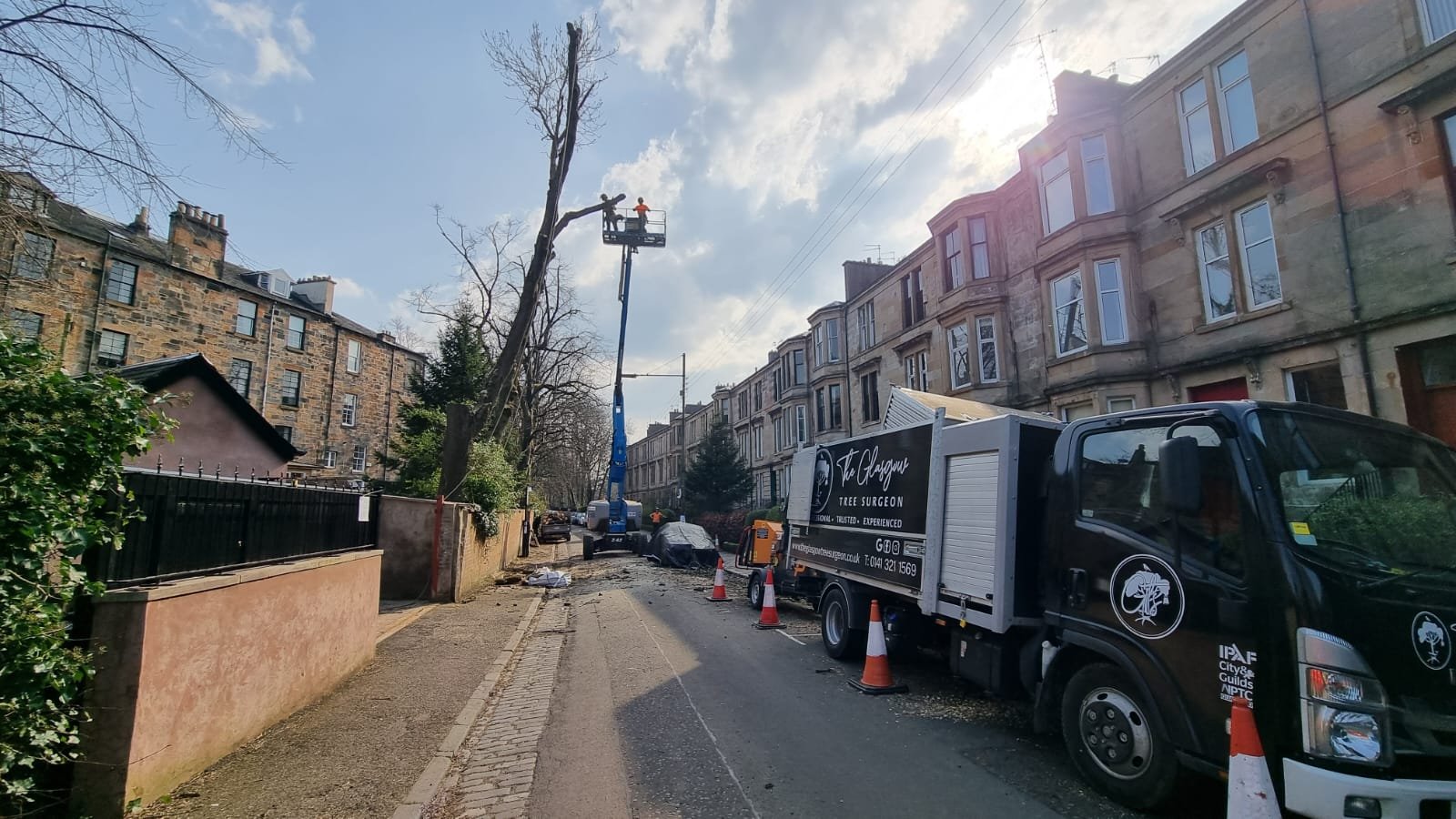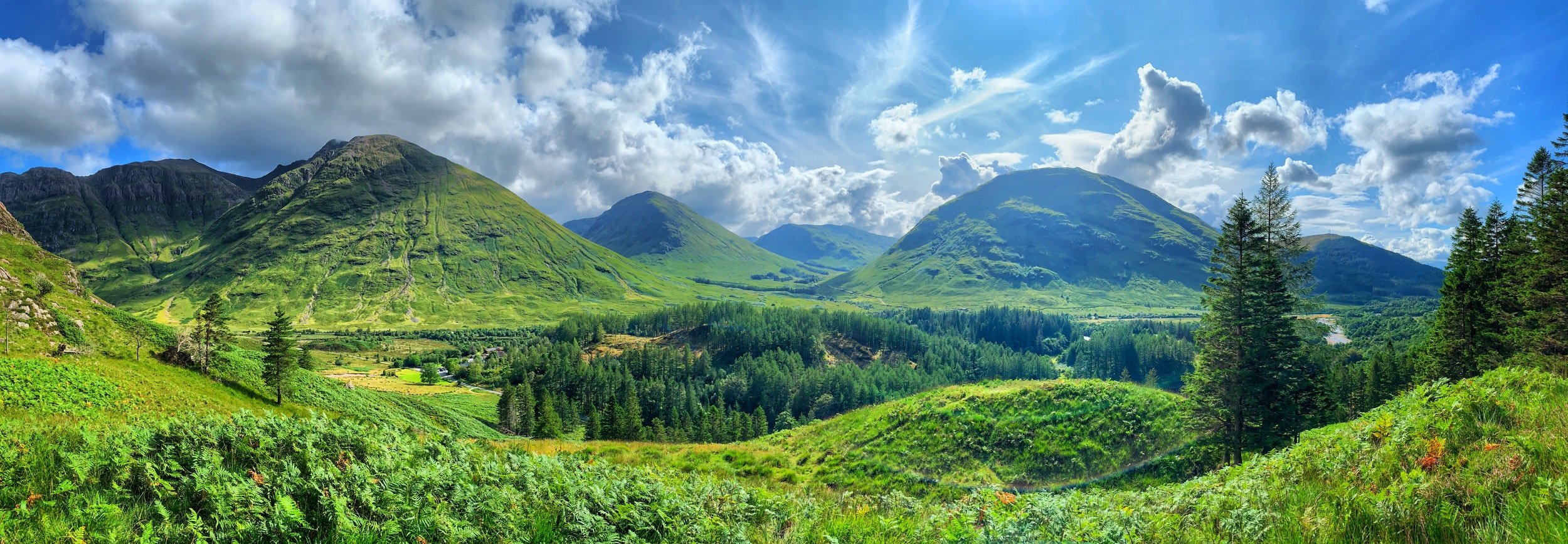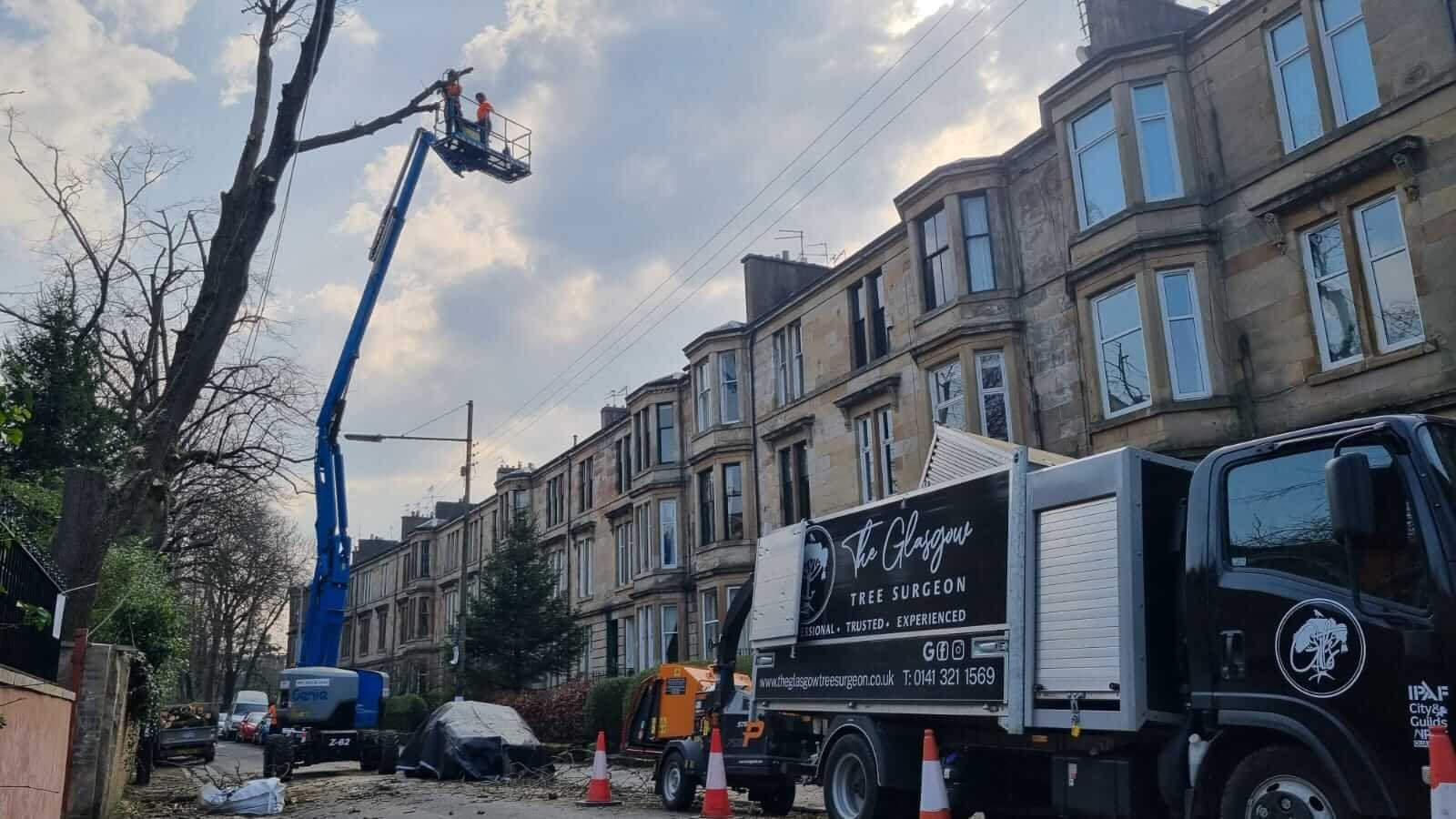tree surgeon West End, Glasgow
We are a locally owned and operated tree care company and proudly serve Glasgows West End and all surrounding areas.
We specialise in all tree services including tree removal, tree trimming, crown reduction, crown lifting, stump removal, emergency tree care and much more.

our services
The Glasgow Tree Surgeon has a team of tree surgeons across Glasgow and surrounding areas providing affordable tree surgery services.
We take great pride in the work we do and keep up to date with the latest industry developments and legislation.
-
Full removal of trees in the West End. Tree felling, tree dismantling and tree removal are terms used to describe the complete removal of trees to ground level which can be carried out at any time of the year except in the presence of roosting bats or nesting birds.
No matter the location and with the correct permissions, we will safely remove your tree whether it is dead, diseased or dangerous, large or small. Where space permits, trees can be felled in one single section however some trees need to be dismantled in sections for a variety of reasons, such as their location to property and buildings, highways, gardens, and even other trees.
In these instances we work off a rope and harness within the tree the Tree Surgeon will carefully dismantle the tree crown and trunk into smaller sections. Rigging equipment and techniques may be used to carefully lower tree sections where there is potential for damage to people and/or property.
We are highly skilled, certified, well equipped, experienced and fully covered with Public Liability Insurance to give you the confidence in our services. The Glasgow Tree Surgeon will carry out all aspects of tree surgery to the latest relevant British standards ‘BS3998′ of tree work, as well as other industry regulations and all our staff are NPTC trained and qualified.
-
The general rule with all pruning works is not to remove more than 25-30% of the crown. More than this would have a negative impact on tree health and therefore the safety of the whole tree or parts of the tree. Over/incorrect pruning (such as topping) destroys the natural form of the tree and can cause accelerated re-growth.
Here are the most commonly applied pruning operations. Crown Cleaning ‘The Safety Prune’ Usually includes the removal of dead, dying, diseased and dangerous branches but may also include the removal of climbing plants, foreign objects, crossing branches and epicormic growth. Crown cleaning may also be undertaken for aesthetic purposes. Objective: safety and/or aesthetic purposes.
-
Reducing the size of the crown without spoiling its shape and maintaining a natural, flowing appearance. The ground rules for a correct crown reduction are:
• Cuts should be made back to natural growth points or lateral branches. This will reduce the amount of decay resulting from the cut and reduce the amount of sprouting from dormant buds around the cut.
• The remaining lateral branch should be at least one-third the size of the branch removed.
• This will retain enough foliage to maintain the energy requirements of the branch and tree and will help maintain the natural form of the tree. The remaining branch will continue to grow at the normal rate so there will be no accelerated re-growth.
• Pruning cuts should be made to retain a flowing branch-line.
-
Lifting Removal of lower branches to a given height.
• Objective/Result: To give headroom for vehicles/pedestrians to open up a view to allow more light into a building or a shaded part of the garden. In many cases crown lifting won’t require a large amount of foliage removal. Taking off 3 or 4 lower branches is often enough to get the desired result.
-
Done primarily on broadleaved trees i.e. not conifers and many evergreens. This is achieved by reducing the density of the crown without reducing the size of the crown. Crown thinning is achieved by crown cleaning and then the removal of secondary growth to achieve an even crown density.
• Objective/result: Allows more light through the crown to reach buildings and plants etc. Reduces the wind resistance, sail and weight of the crown and therefore potentially improves the stability of the tree Improves structure of the tree overall
-
Ideally should be started when the tree is very young. Re-growth is removed on a regular basis (every 1, 2 or 3 years). Pollarding maintains the tree at a constant size. The re-growth has weak attachment points and should not be left to get too big as they will be more prone to failure. Pollarding was originally done for small size timber production at the height above the browsing line of cattle and livestock.
Nowadays it is primarily undertaken as an ornamental form of pruning to regulate tree size. Poor pruning practice – ‘Topping Topping is often confused with ‘pollarding’ or ‘crown reduction’, which are correct methods of reducing and maintaining the size of the crown of a tree. Topping is detrimental to the health and safety of the tree, both by the decay it causes and the disruption to its energy balance. If a topped tree has sufficient vigour it will throw out numerous shoots from where the cuts were made. These grow quickly to replace the lost foliage and can soon develop into branches that reach as far as the original crown of the tree. This accelerated re-growth soon negates the original objective of reducing the size of the crown. At the same time there will be pockets of decay developing where the cuts were made and these will continue to develop and deepen.
-
Accurate felling of the whole tree from ground level where space and safety allow. Section-fell. Required when space and safety do not allow for the tree to be felled from the ground. Working off a rope and harness within the tree the Tree Surgeon will carefully dismantle the tree crown and trunk into smaller sections. Rigging equipment and techniques may be used to carefully lower tree sections where there is potential for damage to people and/or property. Large and/or dangerous trees safely dealt with.
-
Do you have a severely damaged or nuisance Stump? Bearsden Glasgow Tree Surgeons are equipped to provide a superior Stump removal service for the Bearsden and surrounding area. Our Tree Stump Removal is carried out by a machine which can fit through a standard 1.2m gate entrance and grinds to a depth of 20-40cm below ground level. This enables you to re-plant, re-landscape or for building work to take place over the specified area.

We support the rewilding efforts of the highlands
Here at GTS, we remove trees in an environmentally friendly way, re-cycling the wood and woodchips produced. We take tree removal seriously, preferring to maintain and keep our trees healthy. Sometimes trees do need to be removed when they are dead, diseased or dangerous. For every tree we remove we re-plant another tree supporting the rewilding of the Scottish Highlands through our Trees for Life partnership.
health and safety
We are highly skilled, certified, well equipped, experienced and fully covered with Public Liability Insurance to give you the confidence in our services.
The Glasgow Tree Surgeon will carry out all aspects of tree surgery to the latest relevant British standards ‘BS3998′ of tree work, as well as other industry regulations and all our staff are NPTC trained and qualified.
No matter the location
No matter the location and with the correct permissions, we will safely remove your tree whether it is dead, diseased or dangerous, large or small. Where space permits, trees can be felled in one single section however some trees need to be dismantled in sections for a variety of reasons, such as their location to property and buildings, highways, gardens, and even other trees.
focus on safety
Our goal is to get your job done with the use of safe, efficient and affordable tree care. The Glasgow Tree Surgeon is an arboricultural company with over 10 years experience in the professional tree care industry.
contact
Get a free quote
Our friendly, professionally trained teams are ready to discuss affordable options to ensure you get the best value on the market and we always work within your budget.
frequently asked questions
As with many specialist trades it’s often the case that people haven’t heard of an arborist until they need one.
-
As with many specialist trades it’s often the case that people haven’t heard of an arborist until they need one. Tree surgeons, also known as arborists, look after the health of trees right from the beginning tasks of tree planting and nurturing your trees to the removal of established trees. Arborists and tree surgeons will decided if a tree needs to be felled, or dismantled in sections, its health condition and appropriate action that can be taken to maintain and improve its shape within its surroundings.
Tree surgeons have a unique set of skills. They need to be be physically fit to climb up and down trees, be competent and qualified to use and maintain specialist equipment and machinery and keep up to date on the latest advancements. Tree surgeons need to use maths to work out the height of trees and be knowledgeable about the different types of tree and the various funguses and parasites.
Arborists and tree surgeons can study for a foundation degree, higher national diploma or degree and relevant courses include: forestry, arboriculture, countryside management, forest management, woodland ecology and conservation.
Being a tree surgeon is a dangerous profession and needs to be carried out by a qualified team. Risks include falling off or having a tree or branches fall on you. We work with dangerous machines and climbing and rigging equipment, a tree surgeon needs to be a qualified first aider and have the ability to perform a rescue if someone gets into difficulties whilst climbing a tree.
Tree surgeons must ensure the safety of the property and surroundings they are working within, most days we work in public spaces therefore we need rigorous health and safety assessments in place for each job to ensure the safety of the public, our workers plus the equipment and machines at all times.
Arborists and tree surgeons must be fully insured for public and employees liability insurance, if in doubt ask to see your tree surgeon’s insurance cover. Let's take a closer look at what a tree surgeon does.
INSPECTION
The first thing tree surgeons do is discuss a customers requirements and examine a tree and the surrounding area. The tree surgeon will assess if the tree is healthy, if there is any disease, and if the tree itself is a danger. The preliminary examination will determine what next steps can be taken.
PRUNING
If a tree can be saved, the tree surgeon will decide what type of surgery and tree reduction can be operated on the tree. As a general rule no more than 30% of a tree should be reduced at any one time. Limbs and branches that carry disease or have died will be pruned to keep the problem from spreading to the tree as a whole. Pruning a tree should be carried out by an experienced arborist as working at height can be a dangerous task involving using a rope and harness and a climbing chainsaw to reach limbs that are higher up on the tree.
Pruning is also done to remove weight from a tree and keep a tree at a suitable size for its surroundings. Heavier trees are more likely to fall in high winds or when the soil it is in become too saturated from rain to hold its weight. By cutting back or removing limbs altogether, it makes the tree significantly lighter and less likely to fall. Crown lifting, crown reduction and crown thinning are all part of the service.
FELLING TREES
When one of your trees has an infection that is too widespread, it must be removed. The same is true if your tree is infested with parasites. Another reason that your tree may need to be taken down is the threat of it falling on a structure, such as your house. In such cases, tree surgeons will carefully take down your tree a piece at a time to lessen the chance it could fall and do damage to your home or other trees and plants in your garden. You may also no longer want to have a tree for example you may be landscaping, building an extension to your property or from an aesthetic perspective you want to remove it.
-
You can have tree pruning and reducing services at any time of the year, however these services depend on the species of trees you have. Flowering trees that bloom in spring can be trimmed or pruned right after they flower. Those that bloom in summer have to be pruned in early spring. It is recommended to prune fruit-bearing trees during late winter to give them shape and allow sunlight to shine on the core of the tree.
Broad-leaf trees or shrubs without flowers are best pruned in the dormant season, during late autumn or winter. As for dead branches, these can be cut at any time of the year.
If in doubt ask your local arborist tree surgeon.
-
We cover the whole of Glasgow and all surroundings areas.
-
The cost of the work depends on the trees involved, no two trees are the same. Factors include the time it takes, type of labour involved, the specialist equipment used and the access to the site. We will undertake a site visit to work everything out and discuss the requirements with each customer before supplying our quotations.
-
We aim to respond to customers on the same day that they have contacted us. We will visit the site to assess the work and provide a free quotation. We work all year round unless there are high winds or severe weather.
-
Once the trees are removed, we will leave a level stump an inch above the ground. If you require the stump removal, we will bring a stump grinder to grind the stump down below ground level and out of sight.
-
Yes, we will take away all waste, turning branches into woodchips though our woodchipper which are used for biomass fuel. We will take away logs which are dried and re used. If you wish to keep the woodchips or logs, we can leave these with you.
-
Yes, The Glasgow Tree Surgeon is fully insured, up to £5 million Public Liability Insurance and £10 million Employers Liability cover. All staff are first aid accredited and qualified NPTC (National Proficiency Test Council), with an onus on continuing professional development.
-
At The Glasgow Tree Surgeon we recognise the hazards of providing tree care services, we are fully insured to provide peace of mind to all our customers. All of our staff are qualified to carry out the techniques needed and use the equipment on site. If required, we perform safety procedures and work together as a team ensuring the safety of everyone.
-
There are 24 conservation areas across Glasgow, if you live in a conservation area or suspect a tree is covered by a TPO (tree preservation order) any work will need the approval from the local councils Tree Preservation Officer. We can advise you ahead of submitting an application and we can also take on the application process for you directly with the council. Once an application is submitted the council’s TPO will visit the tree and respond to the application with his or her’s decision, this typically takes between 4-6 weeks.


